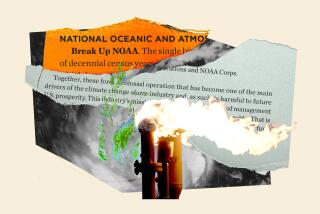H. Guyford Stever dies at 93; former National Science Foundation director
- Share via
H. Guyford Stever, the science advisor to Presidents Nixon and Ford who played a key role in creating NASA and then in restoring its credibility in the aftermath of the 1986 Challenger disaster, died April 9 at a retirement community in Gaithersburg, Md. He was 93.
An aeronautical engineer who spent two decades at MIT and was director of the National Science Foundation, Stever was also the president of the Carnegie Institute of Technology who engineered its 1967 merger with the Mellon Institute of Research to form the prestigious Carnegie Mellon University.
FOR THE RECORD:
H. Guyford Stever: In Tuesday’s LATExtra section, the obituary of H. Guyford Stever, the science advisor to Presidents Nixon and Ford, said his interest in science was stimulated, in part, by the pouring at Corning Glass Works of the 100-inch mirror destined for the Hale Telescope at the Mt. Palomar Observatory. The mirror measures 200 inches across. —
Stever was “a key figure in 20th century science” who strengthened the National Science Foundation’s commitment to basic research and who implemented the first programs studying non-fossil and renewable energy sources research, said the foundation’s current director, Arden L. Bement Jr.
In 1973, President Nixon abolished the White House Office of Science and Technology, which had been established in 1961 by John F. Kennedy, reportedly because Nixon was displeased with its advice about the feasibility of antiballistic missile defenses and commercial supersonic jetliners. He asked Stever, whom he had just appointed head of the NSF, to take on the added role of science advisor, but then rarely consulted him.
When Gerald Ford took over as president, Stever convinced him of the importance of the White House agency and Ford got Congress to re-create it as the Office of Science and Technology Policy in 1976, appointing Stever its first head. Stever continued the funding efforts he had initiated at NSF and promoted more scientific exchanges between the United States and the Soviet Union.
After the Challenger disaster, in which the shuttle blew up 73 seconds after launch, killing all seven astronauts, Stever was named chair of a panel that would oversee redesign of the solid-fuel booster rockets that were responsible for the calamity. Their work was successful and, on Sept. 29, 1988, the U.S. returned to space with the shuttle Discovery.
Horton Guyford Stever was born Oct. 24, 1916, in Corning, N.Y. Both of his parents died of tuberculosis when he was young and Stever and his sister were raised primarily by his maternal grandmother. While he was in high school, his interest in science was stimulated, at least in part, by the nearby Corning Glass Works, where technicians were pouring the 100-inch mirror destined for the Hale Telescope at the Mt. Palomar Observatory. Inspired, the members of his Boy Scout troop built their own telescopes.
He won a scholarship to Colgate University — his family was so poor that neighbors chipped in to buy him a suit for college — where he intended to become a high school science teacher. But his many visits to the Corning Glass Works attracted the interest of Colgate scientists, and they convinced him to pursue a more academic career.
After receiving his doctorate in physics from Caltech in 1941, Stever joined the radiation laboratory at MIT, where he worked on radar and helped teach military men how to use the new technology. His experience led him to be selected as a liaison in London to a team of British scientists working to assess German radar capabilities.
As U.S. forces entered Europe after D-Day, Stever was a member of a team that visited German facilities and installations to analyze German technology. On his first visit to a German radar station in Normandy, the team was captured by German soldiers who were still manning their posts. But once the Germans realized they were behind Allied lines, they surrendered to the scientists.
After the war, he moved through a series of positions to become chief scientist of the Air Force, specializing in guided missiles. After the Russians launched Sputnik on Oct. 4, 1957, he was named chairman of a panel that assessed U.S. space capabilities and that played a key role in establishing NASA.
He received the National Medal of Science in 1991 and the National Science Board’s Vannevar Bush Award, which honors lifelong contributions to science, in 1997.
Stever’s wife of 58 years, the former Louise Risley, died in 2004. He is survived by his sister, Margarette Johnson of Deland, Fla.; two sons, Horton Jr. of Randolph, N.H. and Roy, of Easton, N.H.; two daughters, Sarah Stever of Birmingham, Mich. and Margarette Weed of Oakton, Va.; and seven grandchildren.
More to Read
Sign up for Essential California
The most important California stories and recommendations in your inbox every morning.
You may occasionally receive promotional content from the Los Angeles Times.













